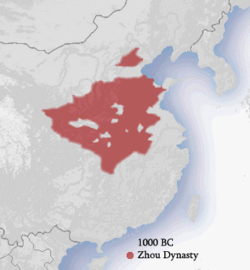
Back Zhou-Dynastie ALS سلالة زو الحاكمة Arabic ঝৌ ৰাজবংশ Assamese Dinastía Zhou AST Çjou sülaləsi Azerbaijani چژوو سولالهسی AZB Чжоу (династия) Bashkir Чжоу Byelorussian Джоу Bulgarian চৌ রাজবংশ Bengali/Bangla
Zhou | |||||||||||
|---|---|---|---|---|---|---|---|---|---|---|---|
| c. 1046 – 256 BC | |||||||||||
 Territory of the Western Zhou (c. 1000 BC) | |||||||||||
| Capital | |||||||||||
| Common languages | Old Chinese | ||||||||||
| Religion | Chinese folk religion, Ancestor veneration, Heaven worship[2] | ||||||||||
| Government | Monarchy | ||||||||||
| King | |||||||||||
• c. 1046–1043 BC | Wu | ||||||||||
• 781–771 BC | You | ||||||||||
• 770–720 BC | Ping | ||||||||||
• 314–256 BC | Nan | ||||||||||
| Chancellor | |||||||||||
| History | |||||||||||
| c. 1046 | |||||||||||
| 841–828 BC | |||||||||||
• Relocation to Wangcheng | 771 BC | ||||||||||
| 256 BC | |||||||||||
• Fall of the last Zhou holdouts[3] | 249 BC | ||||||||||
| Population | |||||||||||
• 273 BC | 30,000,000 | ||||||||||
• 230 BC | 38,000,000 | ||||||||||
| Currency | Spade money | ||||||||||
| |||||||||||
| Today part of | China | ||||||||||
| Zhou | |||||||||||||||||||||||||||||||||||||||||||
|---|---|---|---|---|---|---|---|---|---|---|---|---|---|---|---|---|---|---|---|---|---|---|---|---|---|---|---|---|---|---|---|---|---|---|---|---|---|---|---|---|---|---|---|
"Zhou" in ancient bronze script (top), seal script (middle), and regular script (bottom) Chinese characters | |||||||||||||||||||||||||||||||||||||||||||
| Chinese | 周 | ||||||||||||||||||||||||||||||||||||||||||
| Hanyu Pinyin | Zhōu | ||||||||||||||||||||||||||||||||||||||||||
| |||||||||||||||||||||||||||||||||||||||||||
| Part of a series on the |
| History of China |
|---|
The Zhou dynasty ([ʈʂóʊ]; Chinese: 周)[c] was a royal dynasty of China that existed for 789 years from c. 1046 BC until 256 BC, the longest of all dynasties in Chinese history. During the Western Zhou period (c. 1046 – 771 BC), the royal house, surnamed Ji, had military control over ancient China. Even as Zhou suzerainty became increasingly ceremonial over the following Eastern Zhou period (771–256 BC), the political system created by the Zhou royal house survived in some form for several additional centuries. A date of 1046 BC for the Zhou's establishment is supported by the Xia–Shang–Zhou Chronology Project and David Pankenier,[5] but David Nivison and Edward L. Shaughnessy date the establishment to 1045 BC.[6][7]
The latter Eastern Zhou period is itself roughly subdivided into two parts. During the Spring and Autumn period (c. 771 – c. 481 BC), power became increasingly decentralized as the authority of the royal house diminished. The Warring States period (c. 481 – 221 BC) that followed saw large-scale warfare and consolidation among what had formerly been Zhou client states, until the Zhou were formally extinguished by the state of Qin in 256 BC. The Qin ultimately founded the imperial Qin dynasty in 221 BC after conquering all of China.
The Zhou period is often considered to be the zenith for the craft of Chinese bronzeware.[8] The latter Zhou period is also famous for the advent of three major Chinese philosophies: Confucianism, Taoism and Legalism. The Zhou dynasty also spans the period when the predominant form of written Chinese became seal script, which evolved from the earlier oracle bone and bronze scripts. By the dynasty's end, an immature form of clerical script had also emerged.
Cite error: There are <ref group=lower-alpha> tags or {{efn}} templates on this page, but the references will not show without a {{reflist|group=lower-alpha}} template or {{notelist}} template (see the help page).
- ^ Xu, Zhaofeng. "Considering Chengzhou ('Completion of Zhou') and Wangcheng ('City of the King')" (PDF). Chinese Archaeology. Archived from the original (PDF) on 22 July 2015. Retrieved 22 July 2015.
- ^ "Tian". Encyclopædia Britannica. Retrieved 17 August 2015.
- ^ Schinz (1996), p. 80.
- ^ Baxter, William H.; Sagart, Laurent (2014). Old Chinese: A New Reconstruction (PDF). Oxford University Press. p. 155. ISBN 978-0-199-94537-5.
- ^ Pankenier, David W. (2015). "The cosmo-political mandate". Astrology and Cosmology in Early China: Conforming Earth to Heaven. Cambridge University Press. p. 197. ISBN 978-1-107-53901-3.
- ^ Shaughnessy, Edward L. (1992). "The Date of the Zhou Conquest of Shang". Sources of Western Zhou History: Inscribed Bronze Vessels. University of California Press. pp. 217–236. ISBN 978-0-520-07028-8.
- ^ Nivison, David S. (1983). "The Dates of Western Chou". Harvard Journal of Asiatic Studies. Vol. 43. Harvard-Yenching Institute. pp. 481–580. doi:10.2307/2719108. JSTOR 2719108.
- ^ Von Glahn, Richard (2016). The Economic History of China: From Antiquity to the Nineteenth Century. Cambridge University Press. p. 11. ISBN 978-1-139-34384-8.